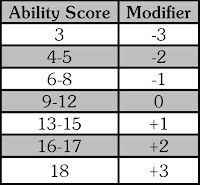I think something else became clearer in the play-test fight I reported as Blood on the Sand. This is that Critical Hits and Special Maneuvers kind of overlap too much. Several times in that fight, I had to stop and think too much about what to do when I got a roll that was both box-cars and 15+. And that turns out to be a pretty common occurence. So I think I need to combine those two things. But which "trigger" to use: box-cars or a Combat Roll of 15+?
I've been debating this for a while now, but I've settled on box-cars being the trigger for a Critical Hit? Why? Well, getting a high roll already has an advantage built-in by the One-Roll mechanic. Plus, I guess I'm just too brainwashed by my past, but I feel like rolling a natural "12" just ought to mean something special. So, here's the new version:
Combat Results
During each of the three Combat Phases (Melee, Missile, and Sorcery), everyone making an attack of that type makes a Combat Roll with varying results:
Roll is snake-eyes: Fumble
Roll is 10- : Miss
Roll is 11+ : Hit
Roll is box-cars: Critical Hit
Fumble
If the attacker is using a weapon made of natural, non-metallic materials, it breaks. The Referee should feel free to apply other results; for example, he may rule that Artifacts also break on a fumble or perhaps just run out of power.
Miss
Um...miss.
Hit
The degree of success indicates base damage done. This is modified by the weapon’s Damage Multiplier.
Critical Hit
A roll of box-cars results in one of two effects: Automatic Hit or Special Maneuver.
Automatic Hit - if the attacker had no chance to roll 11+ due to modifiers (from Weapon vs. AC, opponent's Defense, etc.) , he still hits on box-cars. This hit counts as a Combat Roll as 12 i.e. the degree of success is 2. This means that everyone has at least some chance of hitting any foe.
Break Natural Armour/Shield - if the foe’s armour and/or shield if made of natural materials, it breaks and becomes useless. If both armour and shield are susceptible to this effect, the shield will always break first.
Extra Damage - the weapon’s Damage Multiplier increases by one. A Tiny Weapon goes from x ½ to x1, a Small Weapon goes from x1 to x2, and so on.
Wound - the opponent must roll on the Wounds Table (which usually happens only if reduced to 0 or less HP). This Wound is always temporary.
Knock Down/Back - the foe stumbles back a few feet or falls down. He needs to use a Half-Move to stand up or lose all Defense.
Disarm - the foe’s weapon goes flying out of his hand. He must use a Half-Move to draw another weapon.
Stunning Flurry - a flurry of disorienting blows that forces the foe to make an INT Throw or lose his next turn.
Deadly Display - the character's display of martial prowess is so intimidating that the foe must immediately make a Morale Throw. This is only useful against NPC's as player characters never make Morale Throws.








